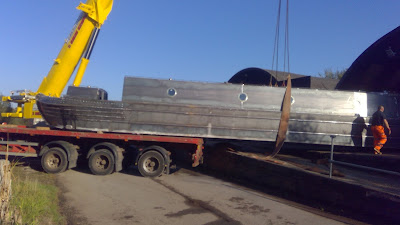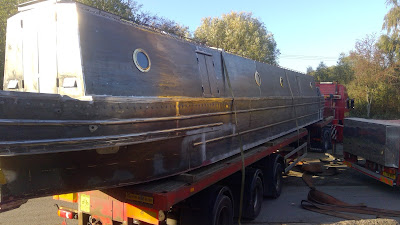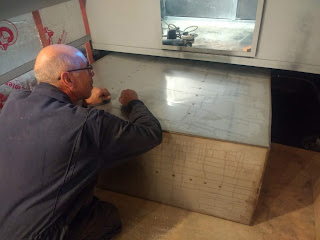Forklift trucks were started and as ladders and steps were pulled away for the last time, it had all the feeling of a plane preparing for take-off or a ship about to leave port.
 The extending flatbed lorry was positioned up to the wall, the mighty crane was alongside. I was amazed at the size of the thing. The driver told me it could lift 220 tonnes, which seemed a bit OTT, but it was what they had available.
The extending flatbed lorry was positioned up to the wall, the mighty crane was alongside. I was amazed at the size of the thing. The driver told me it could lift 220 tonnes, which seemed a bit OTT, but it was what they had available.Very slowly, Garry pushed Calbourne on its rollers, out of the shed and into the October sunshine. I have to admit, it was quite an emotional moment, the culmination of a lot of work and planning.

The plan was to take an initial lift to place the bow on the back of the lorry, then reset the strops to get a full, even lift. They went for a lift, but found the boat was tipping down at the bow. The strops were reset forward by a metre or so and then Calbourne gently became airborne!
The lift confirmed my suspicion that there was too much weight too far forward, in spite of the advice that 'two-thirds of the ballast should be forward of the centreline'.
With a bit of effort on the taglines, the boat was soon lowered dead centre on the lorry, the strops were dropped off and securing straps fitted.
 |
| A big empty space in the build shed! |
Before long, the lorry whisked the boat off to their yard to overnight at Newark, ready for an early start to be at March by 8am.
The lorry was already there when we arrived. I was very anxious to get on board to see how everything, especially the cooker, had fared during the trip. But I wasn't allowed anywhere near, so I would have to wait till she was safely on the water.
The gantry was positioned over the boat. There was a tense moment, when I wondered if the gantry would clear the pigeon box, but all was well. Before long, the boat was dangling by the strops again and the lorry was, somewhat disconcertingly, pulled away, leaving the boat dangling in mid-air.
The gantry was steadily steered round to point at the slipway and with a steady push from the tractor, gracefully slid into the water.
My heart was in my mouth slightly, when I saw how deep the stern went in! All kinds of thoughts rushed through my mind... Had I put too much ballast in? How high were those holes above the waterline? Irrational stuff like that. Then suddenly, she was free of the supports and restraints and was bobbing gently on the water, with her counter an inch or so above the water. She floats! Woohoo! Relief.
That part of the drama over, it was now a question of pulling and pushing the boat to the berth, using only my 15m centreline and a borrowed pole. The difficulty was, she had to be pulled backwards out into the river opening, then turned through 90 degrees, then moved into the basin, then turned 90 degrees again, then forward into the berth. The wind was starting to pick up, which threatened to make life difficult.
 With only myself to do the job, it was a case of passing the rope over numerous boats to be able to get a pull in the right dirction, then jumping back on to work the pole.
With only myself to do the job, it was a case of passing the rope over numerous boats to be able to get a pull in the right dirction, then jumping back on to work the pole.But before too long, I'd got the bow nudged into the berth, when a number of fellow boaters appeared, brandishing poles and offering a hand. With the stern eased round, she slid gracefully into her berth until the bow nudged the wall.
Having secured a couple lines, now I had my opportunity to check inside. With huge relief, I found that both of the ratchet straps had held firm and the cooker was still in situ. Everything else was fine, too. It's been quite a week! But lovely to see Calbourne sitting so pretty on the water at last.





























